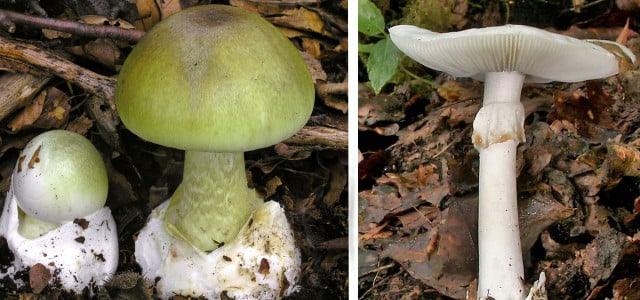
The mushroom season is underway – and with it the risk of dangerous mix-ups increases. There have recently been serious poisonings caused by the green death cap mushroom in several regions of Germany. Doctors and mushroom experts warn urgently: even the smallest amounts can be life-threatening.
With the humid autumn weather and mild temperatures, the high season for mushrooms begins in Germany – and with it the time of utmost caution. The green death cap mushroom (Amanita phalloides) looks very similar to harmless edible mushrooms, but is one of the most poisonous mushrooms in Europe. Consuming even small amounts can lead to acute liver failure.
Recently, several people in Essen had to be treated in intensive care after mushroom poisoning, and some suffered from severe liver failure. In Münster, too, a child was taken to hospital after putting a poisonous mushroom in his mouth in a playground. Cities reacted with barriers and awareness campaigns – but the danger does not only affect North Rhine-Westphalia.
“The green death cap is found throughout Germany – and can appear practically anywhere,” warn experts. Education and respect for unknown mushrooms are the best protection, explains mushroom researcher Gerhard Schuster from the German Society for Mycology (DGfM).
The mushroom has it all: According to the German Liver Foundation, the green death cap is responsible for around 90 percent of deaths due to mushroom poisoning. It is therefore considered one of the most poisonous mushrooms found in Europe.
Recognize green death cap mushroom: This is what the toadstool looks like
- According to the DGfM, the green death cap mushroom is greenish in color, although the color can fade towards the edge.
- The hat is initially hemispherical, later flat and up to 12 cm wide.
- The stem is up to 10 cm long, is whitish and has a bulbous base with a sack-like cover (volva).
- The lamellae are always white, not brownish like mushrooms.
- The smell is reminiscent of artificial honey or sweet invert sugar cream.
Particularly tricky: The mushroom is easily confused with button mushrooms, green mushrooms or pearl mushrooms.
At the top of the photo you can see the green death cap mushroom on the right and left. On the right in the picture is the pigmentless variety of toadstool, which is even more similar to edible white mushrooms. (Photo copyright: German Society for Mycology)
There is also a risk of confusion with other mushrooms:
- Collecting porcini mushrooms: Beware of these lookalikes!
- Recognizing meadow mushrooms: Beware of confusion!
- Collecting parasol mushrooms: There is a risk of confusion here!
- Crested Tintlings: Danger of confusion with other Tintlings
Symptoms of death cap poisoning
Typical symptoms appear eight to twelve hours after consumption – often only after the poison has already spread throughout the body. The most common complaints include:
- severe vomiting
- watery diarrhea
- severe stomach pain
- Circulation problems
The poisons, so-called amatoxins, destroy liver and kidney cells. Without rapid treatment, there is a risk of liver failure and death.
“The faster the therapy begins, the better the chances are that the liver will not be irreparably damaged,” explains Markus Litt-Lampe, specialist in internal medicine at the information center against poisoning at the University Hospital of Bonn (UKB). Early treatment with activated charcoal and the antidote silibinin could be life-saving.
Why the fungus is currently so common
The current concentration of toadstools is linked to the damp, mild autumn weather. Mushrooms love the combination of moisture and warmth – which means they are growing particularly strongly this year. The green death cap lives in symbiosis with deciduous trees such as oaks or beeches, which is why it often appears in parks, on the edges of forests or even on playgrounds.
Mushroom poisoning: what to do in an emergency?
Anyone who suspects that they have eaten a poisonous mushroom should call for medical help immediately – it is best to call 112 or a poison control center.
Important:
- Save leftover fungus, vomit or leftover food and take it with you to the clinic. These help with diagnosis and can save lives.
- Do not use home remedies!
The Federal Office of Consumer Protection and Food Safety provides a list of the relevant poison emergency hotlines on its website.
How to protect yourself from mushroom poisoning
- Only eat mushrooms that can be clearly identified – if in doubt, leave them alone.
- Do not use mushroom apps or images from the Internet as your sole source of determination.
- Mushroom experts can examine collected mushrooms free of charge (address: German Society for Mycology).
- If you want to enjoy mushrooms, you are always on the safe side with cultivated mushrooms from the trade.
Also important: snails or maggots in the mushroom are not a sign of non-toxicity – some animals can tolerate mushroom poisons that are fatal to humans.
Conclusion: Better caution than risk
The green death cap is beautiful but deadly. The risk of confusion is high and people end up in hospital every year because of it. Experts advise: Stay away from unknown mushrooms. If you want to collect mushrooms, you should get training or go with experienced mushroom experts – and if in doubt, it’s better not to.
With material from dpa.
Read more on Techzle\.com:
- Warming up mushrooms – is it dangerous?
- Identify mushrooms: 3 apps in comparison
- Edible mushrooms: You should know these 8 local species
** marked with ** or orange underlined Links to sources of supply are partly partner links: If you buy here, you are actively supporting Techzle\.com, because we then receive a small part of the sales proceeds. More info.